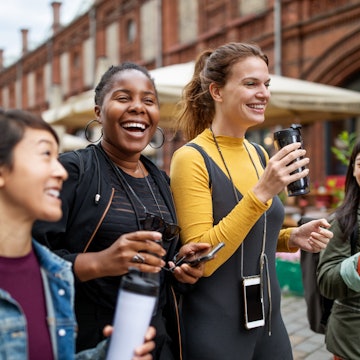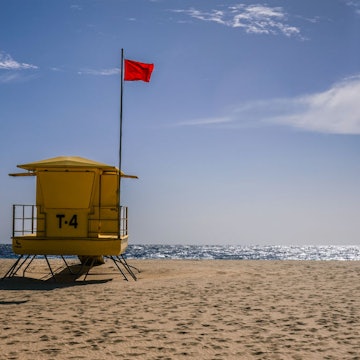

What you need to know about traveling with unvaccinated kids © D3sign/Getty Images
Traveling with children requires a lot of planning at the best of times, and doing so during a pandemic has added a whole new set of difficulties to the permanent adventure of parenting. Traveling with kids who have not received a COVID-19 vaccine can be particularly tricky.
Kunjana Mavunda, MD, a pediatric pulmonologist and travel medicine physician at KIDZ Medical, notes that the Delta variant of the new coronavirus, which is spreading fast, “is more infectious [than previous variants], and has been infecting children more.”
How can you enjoy traveling with kids and make sure that they are safe and that their risk of infection with COVID-19 is kept at a minimum? Here are our tips.
What do I need to know about the COVID-19 vaccines and kids?
At the start of November, the US Centers for Disease Control and Prevention (CDC) updated its recommendations, now advising that children and teens aged 5 and older should get the PfizerBioNTech COVID-19 vaccine, also known as Comirnaty, in order to be protected against the disease caused by the new coronavirus. Previously the vaccine had only been approved for children over 12.
While the vaccine roll-out will now include this lower age group, children and teens in the eligible age groups may not always be able to receive the vaccine.
Daniel Ganjian, MD, pediatrician at Providence Saint John’s Health Center in Santa Monica, CA explains that allergies may prevent some children from getting safely vaccinated.
“One contraindication for vaccines in this age group is if they have had an allergic or anaphylactic reaction to a previous dose of vaccine or any ingredient of the vaccine including PEG—polyethylene glycol,” a substance used in many medications and vaccines, including the Pfizer vaccine.
If possible, however, it is best for children who are eligible to get vaccinated. “We (and the American Academy of Pediatrics) recommend that children get the vaccine because it decreases the severity of the infection as well as the probability of getting the infection in the first place,” Dr. Ganjian notes.
Do children need the COVID-19 vaccine to travel?
Planning international travel with kids can be tough—and rapidly changing border rules add new complications for parents of unvaccinated children.
With many children ineligible for vaccines or yet to receive them, countries around the world are navigating how to allow inbound travel for vaccinated parents and their unvaccinated kids. For example, France, which will only allow vaccinated US travelers for tourism purposes, requires children over 12 to present proof of vaccination, recovery or a negative COVID-19 test to take part in most tourist activities, like eating in restaurants, visiting the Louvre, the Eiffel Tower and theme parks like Disneyland Paris.
In Iceland, kids under 18 years old can travel with their parents—if their parents are exempt from travel restrictions. However, anyone born in or before 2004 will need to be tested at the border and quarantine for 5 days until a second test can be taken—unless they have proof of vaccination. Kids born in 2005 or later are exempt from the rules at the border.
Always check a country’s specific rules for children before planning any travel. As vaccine roll-outs expand to younger kids, border rules may rapidly change to reflect that.
How can I travel safely with children?
Even vaccinated kids could still become unwell if they contract SARS-CoV-2, so in order to fully enjoy your trip, it is important to plan ahead in order to keep your children safe and healthy.
1. Opt for outdoor activities
You may want to consider making plans that involve mostly outdoor settings and activities, Particularly if your kids haven’t had the COVID-19 vaccine.
Read more: How to get your kids to love the outdoors
“Plan on taking a vacation to a tropical place or another place with good weather so you can do many outdoor activities,” Dr. Ganjian advises. “Go camping, hiking or take a road trip in an RV.”

If flying, says Dr. Mavunda, try to opt for arrangements that will minimize children’s contact with other passengers.
“At boarding time, although staff suggests that families with young children and infants board the plane before the general public does, it may be safer to request a seat at the front of the plane, [and] board after everybody else has boarded,” she suggests.
“This way,” Dr. Mavunda explains, “children will have less exposure to other passengers as they go past them.”
2. Ensure all adults wear face masks
As per CDC guidelines for domestic and international travel, while traveling by public transport, adults should wear masks over the nose and mouth. This measure can help keep you, your children, and other travel companions safe. If you are traveling or sharing indoor spaces with people from outside your household or who have not been fully vaccinated against SARS-CoV-2, it is particularly important to ensure that everyone who can will be wearing a mask to prevent viral spread.
“When around people who are not part of your family or who are not or under vaccinated, make sure everybody wears their masks, maintains social distancing, and practices proper hygiene,” says Dr. Ganjian.
3. Get your own vaccinations on track
The CDC also advises adults who want to travel to make sure they are fully vaccinated against SARS-CoV-2, where possible. This is important because the COVID-19 vaccines will not only help protect you against developing severe SARS-CoV-2, but they may also help reduce the risk of spreading the new coronavirus to others, including children and teens in your household.
Remember the instruction to put on your own oxygen mask first in case of an emergency on a flight, so that you can then fit the mask on children who will need your help? It is a little like that with the COVID-19 vaccine: if you are able to receive it, it will help protect your kids too.
4. Follow best practices for hygiene and safety
Another way of keeping your children safe while traveling is by following hygiene and pandemic safety best practices, as outlined by the CDC.
Besides getting a COVID-19 vaccine and wearing a mask in indoor and crowded spaces, the CDC also recommend:
where possible, keeping a distance of 6 feet from people who do not live in your household
making sure you and your kids wash your hands thoroughly for at least 20 seconds as often as possible or, if no soap and water are available, clean your hands using sanitizer with at least 60% alcohol content
covering your mouth and nose while sneezing or coughing if you are not wearing a face mask (the same applies to children and teens)
These best practices for hygiene and safety will help minimize your and your children’s risk of infection in all settings, including while traveling and at your destination.
To motivate children to follow good hygiene practices, Dr. Mavunda suggests turning these practices into an easy routine.
“Children respond well to routines,” says Dr. Mavunda, “and during a trip, parents can continue to emphasize frequent hand washing or frequent use of hand sanitizer, remembering that children adapt well to what they are taught by their parents — and to the behaviors that they see their parents do.”
5. Keep up to date with other vaccinations
It is also important to make sure that children stay up to date with routine vaccinations, which will protect them from other communicable diseases. The World Health Organization (WHO) reports that the COVID-19 pandemic has disrupted routine childhood vaccination programmes around the world. Yet it is now as important as it has ever been to ensure that children are safe from common viral infections.
“Immunization is one of the most powerful and fundamental disease prevention tools in the history of public health,” Dr. Tedros Adhanom Ghebreyesus, WHO Director-General, has said. UNICEF also strongly advises keeping up with routine childhood vaccinations where possible.
Making sure that children are protected against other communicable diseases will also increase their safety and decrease their health risks while traveling, especially if they are likely to come into contact with other children and adults from different households.
To sum up: vaccinate where possible, wear a mask on public transport, keep up good hygiene practices, and opt for outdoor settings if you can. Other than that, just enjoy spending quality time with your kids.
This article was medically reviewed by Dr. Debra Sullivan, Ph.D., MSN, R.N., CNE, COI.
You might also like:
What you need to know about finding and paying for healthcare abroad
How do you choose travel insurance that covers COVID-19?













